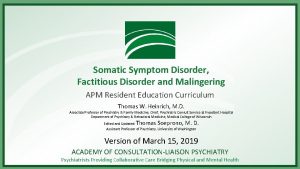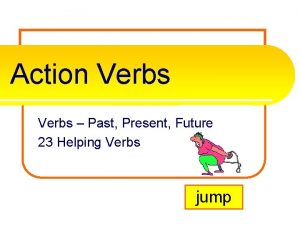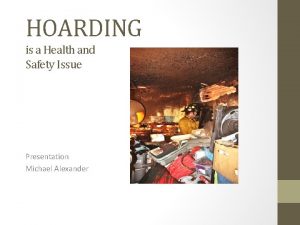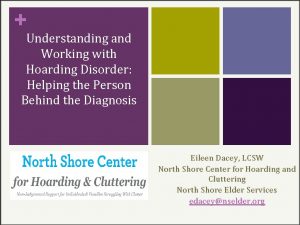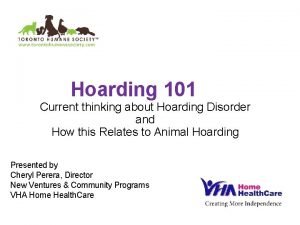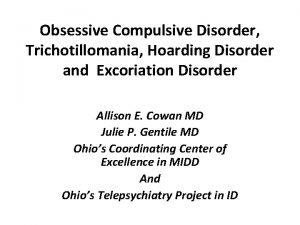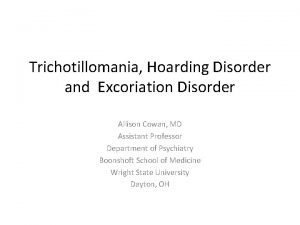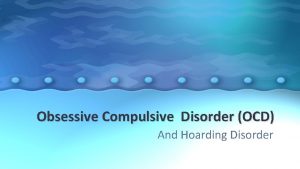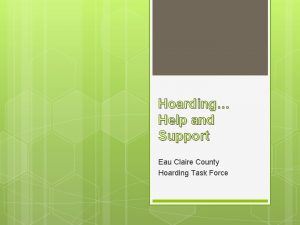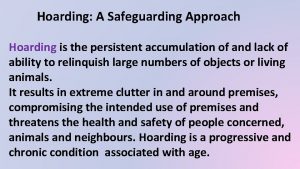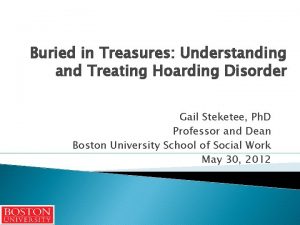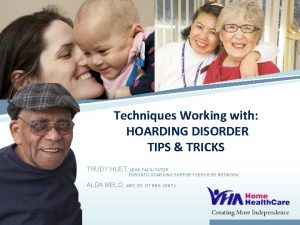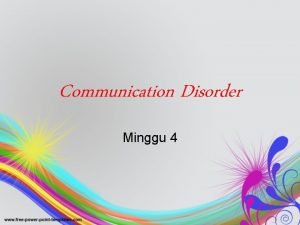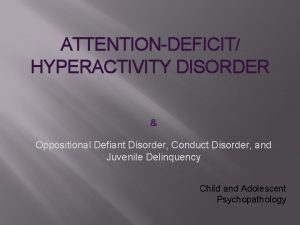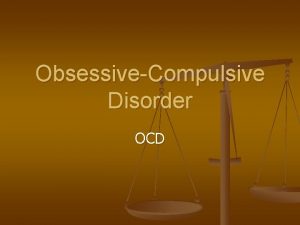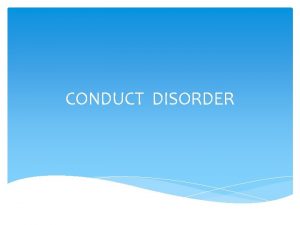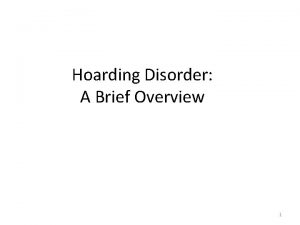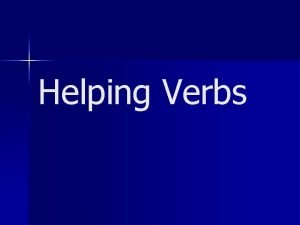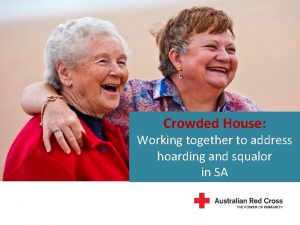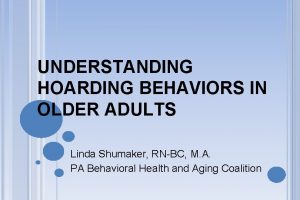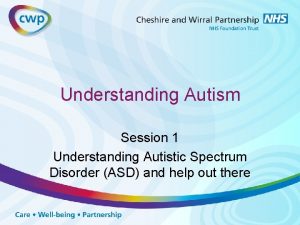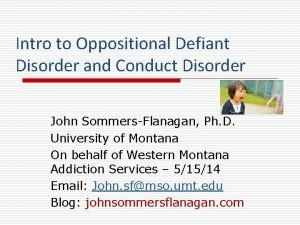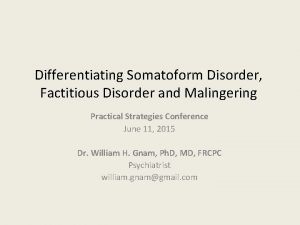UNDERSTANDING AND WORKING WITH HOARDING DISORDER HELPING THE
















































- Slides: 48

UNDERSTANDING AND WORKING WITH HOARDING DISORDER: HELPING THE PERSON BEHIND THE DIAGNOSIS Eileen Dacey, LICSW North Shore Center for Hoarding and Cluttering edacey@nselder. org

Agenda ◦ Overview of hoarding disorder ◦ Variables that maintain hoarding behavior ◦ Description of harm reduction applied to hoarding cases ◦ Training of the Uniform Inspection Checklist (UIC) ◦ Assessment Tools ◦ Question and Answer 2

Hoarding Disorder Awareness Week May 25 -29, 2020 (Left to right: Hannah Mori (Sen. Lovely), Karen Sullivan & Eileen Dacey (NSCHC), and Matt Mogavero (Sen. Lovely)

What is hoarding?

Why hoarding?

Prevalence ◦ Affects approximately 3 -6 % of the population ◦ Roughly 1 out of every 20 people ◦ Suspected 19 million people ◦ Underrepresented amount ◦ Is this just an American issue? ◦ What about SES?

Onset and Course 11 -15 • Hoarding behavior emerges • Hoarding behavior begins interfering with daily 24 -26 functioning • Hoarding now creating clinically significant 34 -36 impairments ◦ Does not meet full criteria until late in life because diagnosis linked to cluttered living spaces. ◦ Average of tx seekers are roughly 55 (Tomkins, 2018) (DSM-5 diagnostic criteria) ◦ Most hoarding items and prevalent careers

Other Factors and FAQs ◦ No link to material deprivation ◦ Genetics? ◦ Hoarding Behaviors triggered by traumatic life events ◦ Higher IQ levels, Education, and Creativity ◦ Perfectionism (cognitive distortions) ◦ Average Age of Treatment seekers ~55 years of age ◦ More Men than Women (Tompkins, 2018)

DSM-5 Diagnostic Criteria ◦ A. Persistent difficulty discarding or parting with personal possessions, even those of apparently useless or limited value, due to strong urges to save items, distress, and/or indecision associated with discarding. ◦ B. The symptoms result in the accumulation of a large number of possessions that fill up and clutter the active living areas of the home, workplace, or other personal surroundings (e. g. , office, vehicle, yard) and prevent normal use of the space. If all living areas are uncluttered, it is only because of others’ efforts (e. g. , family members, authorities) to keep these areas free of possessions. ◦ C. The symptoms cause clinically significant distress or impairment in social, occupational, or other important areas of functioning (including maintaining a safe environment for self and others). (DSM-5, 2013)

Understanding the symptoms of hoarding disorder ◦ Difficulty Discarding: Reluctance to discard personal possessions, including objects that might be considered worthless or have little intrinsic value. Beliefs for saving items are more intense and rigid, and applied to a greater number of possessions. Attempts to discard usually cause substantial emotional distress. ◦ Excessive Clutter: Most visible of hoarding. Can create significant difficulty using living spaces. Clutter can cover beds, chairs, table—rendering them unusable. In severe cases can prohibit movement around the house. ◦ Excessive Acquiring: Compulsive buying, collection of free items—distress related to overspending. (Tolin, Wooton, Worden, Gilliam, 2017) 10

Specifiers of Insight ◦ Specify if: ◦ Good or fair insight: The individual recognizes that hoarding-related beliefs and behaviors are problematic. ◦ Poor insight: The individual is mostly convinced that hoarding-related beliefs and behaviors are not problematic despite evidence to the contrary. ◦ Absent insight: (i. e. delusional beliefs about hoarding): The individual is completely convinced that hoardingrelated beliefs and behaviors are not problematic despite evidence to the contrary. ◦ Excessive Acquisition: ◦ Excessively collecting, buying, or stealing items that are not needed or for which there is no available space ◦ ~80 -90% ◦ Stealing is less common ~10 -15% ◦ Active vs. passive acquisition

What Hoarding Disorder is not. . ◦ Normative Collecting behavior ◦ Cluttered environment that does not cause distress or interfere with ADLs ◦ Temporary situation that can be resolved in six months or less (Tompkins, 2018)

Help Refusal? Variables that maintain hoarding behavior

Hoarding and other conditions 87, 50% 70, 00% 69, 10% 52, 50% 35, 00% 28, 10% 17, 50% 0, 00% Major Depressive D/O 24, 90% 16, 10% 12, 40% 12, 00% 1, 40% Generalized Anxiety PTSD Bipolar D/O 1, 40% Eating D/O (Frost, Steketee, Tolin, & Glossner, 2011)

What are hoarding behaviors? Excessive Saving Acquisition Difficulty Discarding Hoarding Behaviors

Why someone might refuse help ◦ Level of Insight ◦ Good, fair, poor, absent ◦ Information Processing ◦ Perception, Attention Span, Memory ◦ Categorization, Decision Making Deficits ◦ History of complex trauma ◦ Beliefs/Attachments ◦ Beliefs about Possessions ◦ Sentimental, intrinsic, instrumental ◦ Beliefs about Vulnerability ◦ Maladaptive thoughts ◦ Beliefs about Responsibility-waste ◦ Beliefs about Memory and Control ◦ Emotional Reactions ◦ Positive and Negative Emotions Clutter Saving Difficulty Discarding Acquisition (adapted from CBT model for hoarding)

Refusal of help continued. . ◦ Sometimes seeing the problem differently than others ◦ “If I had more space this wouldn’t be a problem. . ” ◦ Fear of help and discovery ◦ Not permitting repairs ◦ Hopelessness ◦ Resentment and mistrust ◦ Personal values (Tompkins & Hartl, 2009, pp. 4 -9)

Information Processing: Notion of Underinclusivity

Hoarders Show 19

Hoarding Behaviors ◦ Hoarding Disorder as a disorder of behavior ◦ Reward and Relief Model: ◦ Behaviors are reinforced by both reward (positive reinforcement) and relief (negative reinforcement) factors ◦ Example: Acquisition is exciting, makes me feel good, purchased something new (reward). The purchase relieved anxiety and calmed me down (relief). Clutter Saving Difficulty Discarding Acquisition

Avoidance Conditioning ◦ ◦ ◦ Distress Decisions Attending to clutter Feelings of loss Feelings of vulnerability Worries about Memory Inviting people into the home Making mistakes Loosing opportunities Losing information Placing items out of sight 21

What isn’t working? ◦ Horizontal vs. vertical ◦ Sometimes seeing that every possession is assigned its own unique category-impossible to organize or group possessions ◦ Churning-inefficient strategies continued ◦ Clutter blindness ◦ Varying attributes of each item (Tompkins & Hartl, 2009, pp. 18 -19)

Guidelines for Initial Assessment ◦ Provide Rationale for Home Visit. ◦ Do not touch anything without EXPLICIT permission. ◦ Each decision must be the client’s decision. Can be guided by therapist, not decided by therapist. ◦ Try to keep the home visit as short as possible. ◦ Decide where to begin treatment. ◦ Photograph all rooms of the home. ◦ Use assessment tools. ◦ Involve family members who live in the home. ◦ (Tompkins, 2018)

◦ How many do you already have? Is that enough? Challengin g Questions Enhancing Insight ◦ Do you have enough time to use, review, or read it? ◦ Have you used this during the past year? ◦ Do you have a specific plan for this item? By when? What is the likelihood that you will use this item again? ◦ Does this fit with your values and needs? Is it important because you’re looking at it now? ◦ Is it current, of good quality, accurate, reliable? ◦ Would you buy it again if you didn’t already own it? ◦ Do you really need it? Could you get it again if you really needed it? Do you have enough space for this?

Guidelines for Treatment Imagine yourself in the client’ s position Model positive, adaptive behaviors Provide encouragement and emotional support Share your opinions when asked, emphasizing transparency Believe in the client’ s ability Highlight strengths, always provide positive validation Stay calm… even when it is tough Take care of yourself DON’T Do Any of the Following: Use judgmental language Touch belongings without explicit permission Declutter behind the client’ s back, or say you will donate something and throw it away instead Minimize the challenges faced Make decisions Equate the clutter with the person Argue or try to persuade (Bell, 2012)

Exploring themes ◦ Ask your client about their theory of why they hoard: ◦ When did you notice that this started for you? ◦ Why do you think it started? ◦ Where there any particular triggers? ◦ What was it like for you growing up? ◦ What are some of the things that are particularly difficult to discard? ◦ Why is it so hard for you to let these items go? (Kellett et al. , 2010)

HARM REDUCTION

Varying approaches for hoarding disorder o Typical approaches for hoarding include treatment o Often, Cognitive Behavior Therapy (CBT) o What happens when the case is not a self-referral? o How do you help someone who doesn’t want help? o To intervene in cases of severe hoarding through an alternative approach: o When a person refuses help, yet faces serious consequences (Tompkins, 2015)

What is Harm Reduction? ◦ A holistic and humane public health approach designed to minimize risks. ◦ First developed to minimize risks of intravenous drug use (Marlatt, 1998) ◦ Smoking-cessation ◦ Family planning ◦ Seat-belt campaigns ◦ School vaccination ◦ Health screening fairs (Tompkins & Hartl, 2009, pp. 29)

Harm reduction is. . ◦ Every person is different and driven by their own ◦ Internal and external needs ◦ HR is meeting the client where they are ◦ Think of staying with them, not ahead of them (Denning & Little, 2012, pp. 42)

Harm Reduction for Hoarding ▪ Pragmatic principles and compassionate strategies designed to minimize harmful consequences of high risk behaviors ▪ Avoid consequences associated with severe hoarding such as death, injury and homelessness ▪ People with severe hoarding do not typically seek treatment ▪ Yet… ▪ Face severe risks ▪ Little awareness of the severity of the problem (Tompkins, 2015)

What is severe hoarding? o Are at risk for serious injury or even death because of the environment that they live in. o Falls, avalanches, structural concerns o Also exhibit low functional capacity o Ability to perform tasks necessary to live their lives o Physical capacity o Social capacity o Cognitive/Psychological capacity o Low insight/refusal to accept help as most significant (Tompkins, 2015)

Health and Safety Risks 98% 70% 50% 45% 42% 10% Category 1 Moderate difficulty moving around house Unable to use stove tops or oven Unable to use sinks Unable to use furniture Unable to use refrigerator or freezer Unable to use toilets (Frost, et al. 2000)

Principles of Harm Reduction ◦ First, do no harm ◦ (ill-conceived cleanouts) ◦ It is not necessary to stop all hoarding behavior ◦ Identify the specific ways the hoarding problem puts the client in harm’s way ◦ No two hoarding situations are identical ◦ Generate a team approach ◦ The client is an essential member of the HR team ◦ Change is slow ◦ Agreement failures do not mean the HR approach is failing ◦ The client may have more pressing problems than hoarding (Tompkins, 2015, pp. 49 -56) (Image from: “What is Harm Reduction? ” by Mc. Gill University)

Principles of Harm Reduction cont. ◦ Respect: nonjudgmental understanding of each individual and “where they are at” ◦ Acceptance: that hoarding is a complex, multi-faceted phenomenon ◦ Empowerment: of the individual as the primary agent of change ◦ Compassion: towards the realities of social isolation, past trauma, discrimination, and other social inequalities and vulnerabilities people face ◦ Collaboration: supporting individuals in developing & implementing strategies that are personally meaningful (Image from: “What is Harm Reduction? ” by Mc. Gill University)

Establishing harm reduction targets ◦ HR targets that focus on environmental risks: clearing egresses, clearing cooling/heating vents (think UIC) ◦ HR plan should also include functional capacity: ◦ Physical ◦ Psychological ◦ Social ◦ All interact with the functional capacity of the client to influence harm potential (up or down) ◦ The assessment of the capacity of the client in the home provides most relevant information about the ability to live safely and independently. ◦ Think about relevant cues ◦ Be mindful of distractions within the home. (Tompkins, 2015)

Questions to identify HR targets ◦ How often do you cook meals ◦ How often do you open the on the stove? mail? ◦ How often do you sleep in your ◦ How often have you fallen in bed? the house in the past year? (Where) ◦ How often do you use the shower? ◦ What makes getting around your home hard for you? ◦ Do you use a cane/walker, and does that help? ◦ What appliances do not work? ◦ How often do you forget to take Where do you cook? your meds and where do you ◦ Where do you use the toilet? keep them? ◦ How often do you miss paying ◦ Do you ever misplace the med. a bill because you cannot find bottles? your checkbook? (Tompkins, 2015, pp. 242 -243)

Goals of harm reduction ◦ Keep people safe and comfortable in their homes ◦ Focus on moving possessions away from highrisk areas ◦ Focus on creating systems to minimize acquisition and maintain safety ◦ Focus on creating systems to enhance effective living ◦ Focus on managing other problems and conditions that influence harm potential (Tompkins, 2014 presentation on harm reduction)

When to make a mandated report • Mandated reporters must report when they observed or suspect abuse or evidence of neglect • Many people who hoard are not accurate reporters to the degree and extent of their hoarding problem • First, visit the residence • Focus on imminent risk • Presence of animal/human excrement (sensory blunting) • Consuming spoiled foods • Significant structural damage • Discuss the report with the resident • Call (800 -922 -2275) for APS report

Harm Reduction Video ◦ Harm Reduction Video

Assessment Tools ◦ Clutter Image Rating ◦ Assessing ‘volume’ http: //www. ocfoundation. org/hoarding/cir. pdf ◦ H. O. M. E. S. – Multi-disciplinary Hoarding Risk Assessment ◦ Assessing risk http: //www. masshousing. com/hoarding ◦ Uniform Inspection Checklist – Hoarding / Excessive Clutter ◦ Minimum safety and sanitation standards http: //www. masshousing. com/hoarding 41

Not for reproduction or use without the expressed written permission of Eileen Dacey, MSW , LCSW 978. 624. 2207 edacey@nselder. org 42

Assessment Tools

Uniform Inspection Checklist

Engagement and Motivation 1. If you woke up tomorrow and your home was just the way you want it to be, how would your life be different? 2. What is something you want to do that you currently are not doing or cannot do because of the clutter in your home? Taking a Strengths-Based Approach

What we want success look like.

Redefining our Perception of Success Have we minimized the risks? Is it safe and functional for the resident? Is the client aware of the risks?

Resources http: //vet. tufts. edu/hoarding/ http: //nselder. org/north-shore-center-for-hoarding- decluttering/ https: //www. aspca. org/ http: //massanimalcoalition. org/ https: //www. arlboston. org/ https: //www. facebook. com/groups/Hoarding. Task. Force. Network www. masshousing. com/hoarding www. ocdfoundation. org http: //www. mutual-support. com/ https: //www. facebook. com/groups/The. Clutter. Movement. Individual. Support https: //www. facebook. com/groups/The. Clutter. Movement. Family. Support/ http: //thehoardingproject. org/home/
 Hoarding disorder بالعربي
Hoarding disorder بالعربي Ocd nursing care plan
Ocd nursing care plan 23 helping verbs
23 helping verbs Hoarding presentation
Hoarding presentation Learning targets helping students aim for understanding
Learning targets helping students aim for understanding Conversion vs somatic symptom disorder
Conversion vs somatic symptom disorder Hot working and cold working difference
Hot working and cold working difference Hot working of metals
Hot working of metals Machining operations
Machining operations Proses pengerjaan panas
Proses pengerjaan panas Hard work vs smart work
Hard work vs smart work Hát kết hợp bộ gõ cơ thể
Hát kết hợp bộ gõ cơ thể Ng-html
Ng-html Bổ thể
Bổ thể Tỉ lệ cơ thể trẻ em
Tỉ lệ cơ thể trẻ em Gấu đi như thế nào
Gấu đi như thế nào Tư thế worm breton là gì
Tư thế worm breton là gì Chúa yêu trần thế
Chúa yêu trần thế Các môn thể thao bắt đầu bằng tiếng đua
Các môn thể thao bắt đầu bằng tiếng đua Thế nào là hệ số cao nhất
Thế nào là hệ số cao nhất Các châu lục và đại dương trên thế giới
Các châu lục và đại dương trên thế giới Công của trọng lực
Công của trọng lực Trời xanh đây là của chúng ta thể thơ
Trời xanh đây là của chúng ta thể thơ Mật thư anh em như thể tay chân
Mật thư anh em như thể tay chân Làm thế nào để 102-1=99
Làm thế nào để 102-1=99 độ dài liên kết
độ dài liên kết Các châu lục và đại dương trên thế giới
Các châu lục và đại dương trên thế giới Thơ thất ngôn tứ tuyệt đường luật
Thơ thất ngôn tứ tuyệt đường luật Quá trình desamine hóa có thể tạo ra
Quá trình desamine hóa có thể tạo ra Một số thể thơ truyền thống
Một số thể thơ truyền thống Cái miệng nó xinh thế
Cái miệng nó xinh thế Vẽ hình chiếu vuông góc của vật thể sau
Vẽ hình chiếu vuông góc của vật thể sau Biện pháp chống mỏi cơ
Biện pháp chống mỏi cơ đặc điểm cơ thể của người tối cổ
đặc điểm cơ thể của người tối cổ Giọng cùng tên là
Giọng cùng tên là Vẽ hình chiếu đứng bằng cạnh của vật thể
Vẽ hình chiếu đứng bằng cạnh của vật thể Tia chieu sa te
Tia chieu sa te Thẻ vin
Thẻ vin đại từ thay thế
đại từ thay thế điện thế nghỉ
điện thế nghỉ Tư thế ngồi viết
Tư thế ngồi viết Diễn thế sinh thái là
Diễn thế sinh thái là Dạng đột biến một nhiễm là
Dạng đột biến một nhiễm là Bảng số nguyên tố
Bảng số nguyên tố Tư thế ngồi viết
Tư thế ngồi viết Lời thề hippocrates
Lời thề hippocrates Thiếu nhi thế giới liên hoan
Thiếu nhi thế giới liên hoan ưu thế lai là gì
ưu thế lai là gì Khi nào hổ con có thể sống độc lập
Khi nào hổ con có thể sống độc lập
